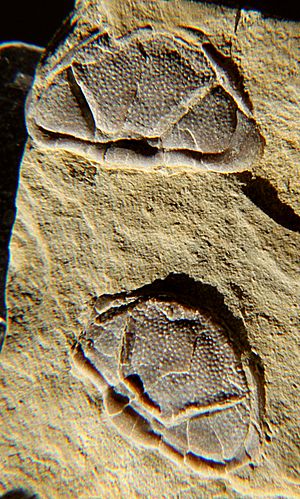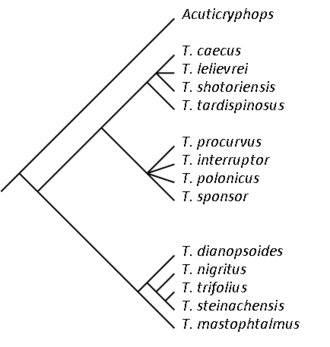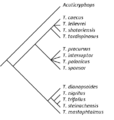Trimerocephalus facts for kids
Trimerocephalus was a type of ancient sea creature called a trilobite. Trilobites were a group of Arthropods, which means they had hard outer shells and jointed legs, much like modern-day crabs or insects. Trimerocephalus lived a very long time ago, during the final part of the Devonian Period, a time in Earth's history from about 419 to 359 million years ago. Specifically, it lived during the Famennian stage, which was from about 372 to 359 million years ago.
One special thing about Trimerocephalus is that it was completely eyeless! It became extinct at the end of the Famennian stage, along with most other trilobites. Fossils of Trimerocephalus have been found in many places around the world, including Australia, the Czech Republic, France, Germany, Iran, Kazakhstan, Morocco, Poland, Russia, Spain, and the United Kingdom.
Quick facts for kids Trimerocephalus |
|
|---|---|
 |
|
| Two cephalons of the trilobite Trimerocephalus interruptus | |
| Scientific classification | |
| Kingdom: | |
| Phylum: | |
| Class: | |
| Order: |
Phacopida
|
| Suborder: |
Phacopina
|
| Superfamily: |
Phacopoidea
|
| Family: |
Phacopidae
|
| Genus: |
Trimerocephalus
M'Coy, 1849
|
| species | |
|
|
| Synonyms | |
|
Eutrimerocephalus |
|
Where Trimerocephalus Lived
Fossils of Trimerocephalus have been found across Europe, North Africa, Iran, and Australia. This shows that these ancient creatures were spread out over a wide area during the Devonian Period.
Many different types of Trimerocephalus have been discovered. For example:
- T. caecus fossils were found in Poland, Germany, Russia, North Africa, and France.
- T. lentiginosus and T. cryptophthalmoides were found in Russia and Kazakhstan.
- T. interruptus, T. dianopsoides, T. polonicus, and T. trifolius were all found in Poland.
- T. lacunosus and T. steinachensis were found in Germany.
- T. lelievrei was found in Morocco.
- T. mastophthalmus was found in Germany, Poland, England, and Kazakhstan.
- T. mimbi and T. tardispinosus were found in Western Australia.
- T. nigritus was found in France.
- T. procurvus and T. sponsor were found in Spain and the Czech Republic.
- T. shotoriensis was found in Eastern Iran.
- T. vodorezovi was found in Kazakhstan.
These discoveries help scientists understand how these trilobites lived and moved across the ancient Earth.
What Trimerocephalus Looked Like
Trimerocephalus is special because it was one of several types of phacopid trilobites that had no eyes. Other eyeless trilobites include Dianops and Ductina.
Here are some key features of Trimerocephalus:
- Head (Cephalon): The top part of its head, called the dorsal facial sutures, was not separate. This means the head shield and the free cheeks (side parts of the head) were always found together.
- Cheeks: The edge around its cheeks was wide and curved outwards.
- Underside of Head: The part of the head that tucked underneath, called the doublure, was short and flat.
- Groove for Rolling Up: It had a wide and deep groove, called a vincular furrow. This groove helped the trilobite roll itself into a ball for protection, like a modern-day pill bug. The edge of its tailpiece would fit perfectly into this groove when it rolled up.
- Tail (Pygidium): Its tail section was about three times wider than it was long.
These features help scientists identify Trimerocephalus fossils and learn more about how these ancient creatures lived without eyes in the deep, dark waters of the Devonian seas.
Images for kids




